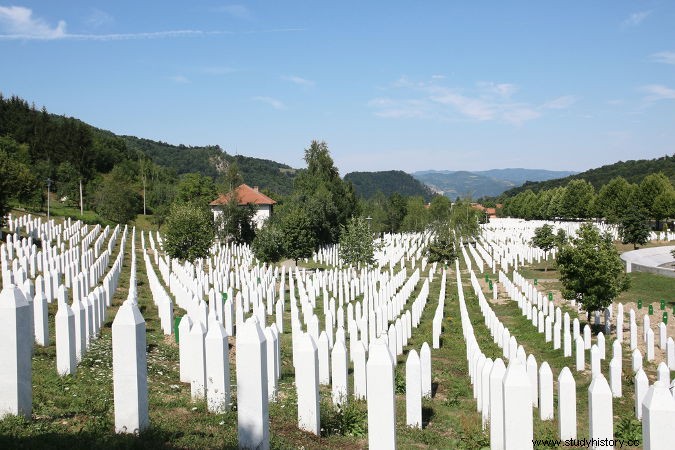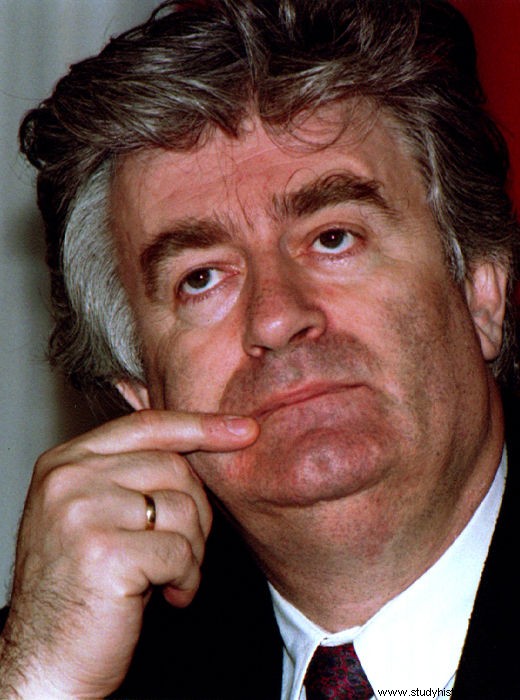
The Bosnian War took place from 1992 to 1995 after Bosnia and Herzegovina's declaration of independence. The conflict was an offshoot of existing ethnic rivalries in Yugoslavia and took place during that country's fragmentation. It resulted in more than 100,000 deaths and was marked by war crimes, mainly against Bosnian Muslims (Bosniaks).
Formation of Yugoslavia
The foreign presence in the region that formed the former Yugoslavia resulted in major independence movements. An example of a movement was the Mlada Bosnia , responsible for the death of Archduke Franz Ferdinand in 1914, which resulted in the start of the First World War.
With the end of the First World War, a prototype of Yugoslavia emerged in 1918 called the “Kingdom of Serbs, Croats and Slovenes”, which became the Kingdom of Yugoslavia in 1929. This kingdom was fragmented during the Second World War with the Italian and German invasion and was only reunited at the end of the conflict. The leadership of post-war Yugoslavia was carried out by General Josip Broz Tito .
Titus inaugurated, in 1945, the Federal Socialist Republic of Yugoslavia , a nation that brought together six different countries:Serbia, Croatia, Slovenia, Montenegro, Macedonia and Bosnia and Herzegovina . The region's ethnic and religious rivalries were controlled by the dictatorial power of Tito. However, with the death of this general in 1980, the nationalist movements were strengthened.
The growth of nationalist movements resulted in the emergence of leaders for each of the different ethnicities, especially Franjo Tudman (Croatian), Slobodan Milosevic (Serbian) and Alija Izetbegovic (Bosnian). The political debate in Yugoslavia in the late 1980s and early 1990s focused entirely on ethnicity. The end of Soviet influence, after its collapse in 1991, was the last element that propelled the independence movements.
Fragmentation of Yugoslavia
The fragmentation of Yugoslavia began with the declarations of independence of Slovenia and Croatia in 1991. These statements were responded to with attacks by Yugoslav forces on both countries. The conflict in Slovenia lasted only 10 days, and the conflict in Croatia lasted until 1995. A third country declared itself independent in 1991:Macedonia .
In this context, Bosnian President Alija Izetbegovic reinforced the desire to declare Bosnia-Herzegovina's independence. The Bosnian independence movement was more complex due to the great ethnic diversity existing in the country, as “in 1991, 44% of the 4.4 million inhabitants were Bosnian-Muslims, 31% Serbs and 17% Croatians” |1| .
Bosnia's three largest ethnic groups had diverse interests:the Bosniaks they advocated full independence for Bosnia and the establishment of a government headed by Bosniaks; the Serbs they advocated the annexation of Bosnian territories where the majority of the population was Serb to Yugoslavia; and the Croats advocated the full annexation of Bosnia to Croatia.
Bosnian Serbs were represented by Radovan Karadzic, who advocated an aggressive stance against the Bosniak population and threatened to start war if Bosnia declared its independence. In late 1991 and early 1992, Serbian troops were deployed to the outskirts of Sarajevo, completely encircling the city. The war began in April 1992, when the Serbian population of Sarajevo began to attack the Bosniak population.
Events of the War

Radovan Karadzic, leader of the Bosnian Serbs, was sentenced to 40 years in prison for the genocide carried out by his troops in the war *
With the war on, the Bosnian Serb armies prevailed against the ill-prepared Bosniak forces. The city of Sarajevo , the capital of Bosnia, was completely surrounded by Bosnian Serbs, who were also advancing through other parts of Bosnian territory.
The war was marked by the Serbian attempt to carry out the ethnic cleansing of Bosnia through the extermination of the Bosniak population, as evidenced by Gustavo Silva's account of a massacre carried out in a nearby village from Srebrenica:
Hundreds of men were captured near the villages of New Kasaba. They were taken to the city's football stadium. An American spy plane took an aerial photo of the place, where six hundred men were concentrated on the lawn. When the same plane flew over the area again days later, the men were gone, and the areas around the stadium looked different:the vegetation was gone, and signs of recent excavations were evident. The conclusion:they were mass graves|2| .
Bonian Serbian control in the war lasted until mid-1994, when Serbia was forced by Western powers to withdraw its support from the troops of Radovan Karadzic and Ratko Mladic (General of the Serbian Armies -Bosnians). In addition, the entry of foreign troops into the Bosnian army, mainly Iranian, and the financial support of Muslim countries contributed to Bosnia reversing the negative situation at the beginning of the war.
Serb troops stationed at the siege of Sarajevo bombarded the city with heavy artillery for months, and elite artillerymen were ordered to fire indiscriminately at civilians who were spotted walking through the city's streets. In addition, in villages in the Bosnian countryside, numerous massacres were recorded, the best known of which was that which took place in the Srebrenica safe zone. .
At the end of the war, Bosnian Serb armed groups invaded the security zone and carried out a massacre, which resulted in the death of more than 8,000 Bosniaks. Part of the Bosniak population began a desperate flight through the forests of the region to survive. The survivors had to walk more than 30 kilometers through the forests.
The isolation of Bosnian Serb forces led Karadzic to accept the peace negotiation in the Dayton Agreement, in 1995. In this agreement terms were established for independent Bosnia and for maintaining peaceful coexistence in the country. Two internal federations were also created to group the different ethnic groups:the Federation of Bosnia and Herzegovina, under control of Bosniaks and Croats, and the Serbian Republic of Bosnia, under Bosnian Serb control.
Many of those responsible for the war crimes committed in Bosnia were tried in international courts, and many were convicted of genocide and other war crimes. Karadzic, for example, was convicted to 40 years in prison.
|1| SILVA, Gustav. From rose to dust:Stories from post-genocide Bosnia. Rio de Janeiro:Tinta Negra Bazar Editorial, 2011, p.17.
|2| Ditto, p.81
*Image Credits:Northfoto and Shutterstock
Take the opportunity to check out our video lesson on the subject:
